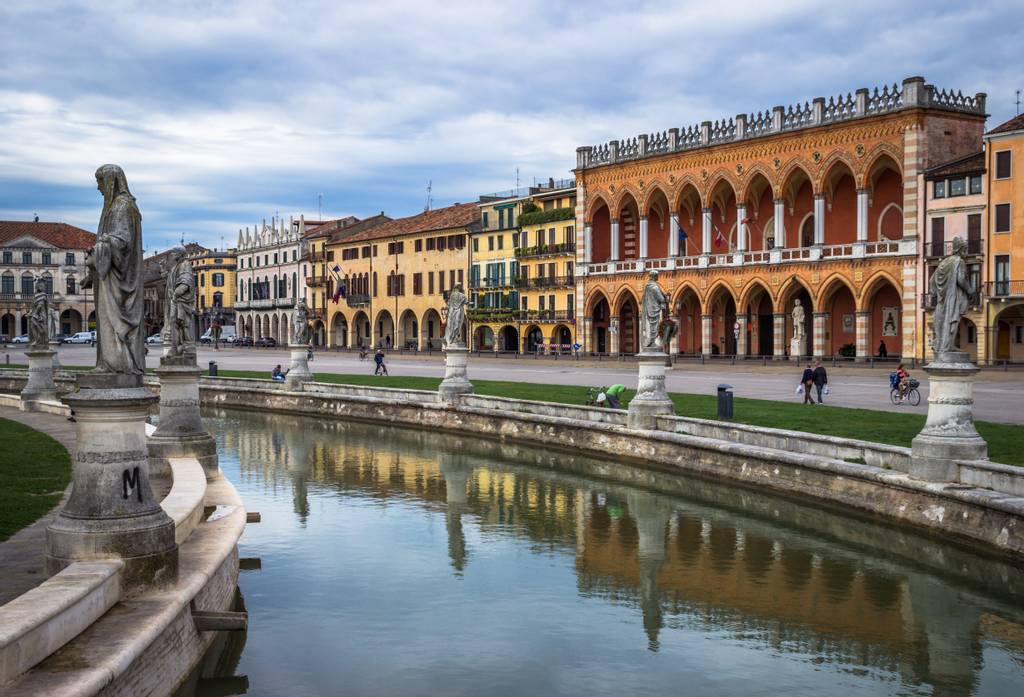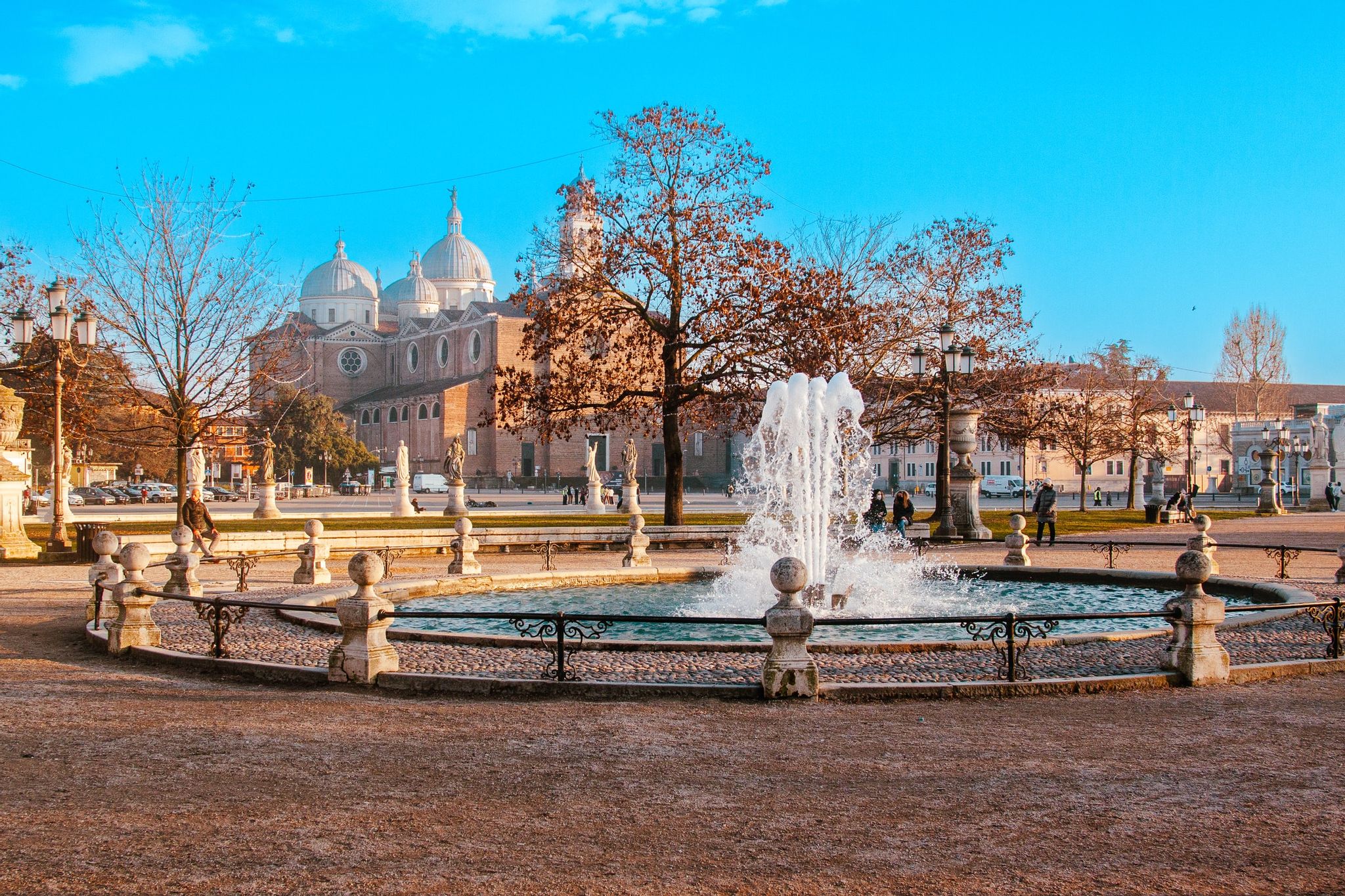Prato della Valle
Prato della Valle in Padua is one of the most spectacular squares in the world and, with its 90,000 square meters, is one of the largest in Europe.

Prato della Valle, the monumental square of Padua, is one of the most active and animated places in the city, very popular with paduans and visitors. It brings together many who are strolling, skating, studying, or just relaxing for a moment while sunbathing.
Every Saturday is held a traditional market with over 160 stalls, while the antique market takes place every third Sunday of the month. The square is often used to host events and concerts and is an excellent stage for the traditional fireworks of New Year's Eve and Ferragosto – the Italian public holiday celebrated on the 15th of August.
Its name, Prato della Valle, translates as “Meadow of the valley”. In the Roman and early Middle Ages, the area was referred to as Valle del Mercato for the markets and seasonal fairs held here. In 1775, Andrea Memmo, the city's Venetian Superintendent, decided to reclaim and restore this area of Padua, which decayed to a swamp over the years. He commissioned Domenico Cerato, a professor of architecture at the University of Padua, to design the new square. Prato della Valle was to be transformed into an appropriate setting for the traditionally held events whilst also being suitable for providing recreation for the paduans. It was laid out on the footprint of the ancient Roman arena that was once housed here, giving the project a sense of historical dignity.
After a long period of decline in the eighties, the square underwent a redevelopment process in the nineties and is now one of the city’s crown jewels. Today, the square is still as beautiful as envisioned in the 18th century, a remarkable architectural context of great beauty.
The layout is based on an elliptical island at the centre of the square, known as Isola Memmia, in honour of its creator, Andrea Memmo. The island is cut across by two perpendicular avenues shaded by about forty Norway maple trees and lined with sixteen ornamental vases. In the island’s centre is a fountain surrounded by Istrian stone benches, inaugurated in 1926.
It is surrounded by an artificial canal, crossed by four bridges on the ellipse axes, connecting the square to the island: the North Bridge, the Popes’ Bridge, and the two Obelisks’ bridges. The Alicorno canal supplies the water, a branch of the Bacchiglione river, and an integral part of the old canal system of Padua. Under the Popes’ Bridge, so-called for the four statues of popes that decorate the bridge, the waters of the Alicorno enter and exit, feeding the spectacular ring of water surrounding the island.
The small canal is bordered by a double row of statues, a perfectly symmetrical arrangement of 78 statues and eight obelisks, all made of Vicenza stone. The statues represent the most illustrious sons of the city by birth or adoption. Along the bridges were crowded together popes, doges, various noblemen, professors and students of Padua's University, and other famous people from the history of Padua. These include, among others, the mythical founder Antenore, Tito Livio, Torquato Tasso, Ludovico Ariosto, Andrea Mantegna, Francesco Petrarca, Galileo Galilei, and Andrea Memmo.
However, this is a pantheon incomplete. On the northern bridge, there are two empty pedestals. Formerly here were the statues of two doges, which like the other doge statues placed on the east and west bridges, where the obelisks stand today, were destroyed after the fall of the Serenissima.
Other statues damaged over time by atmospheric agents have been replaced or restored. The statue of the Marquis Poleni, sculpted by Antonio Canova in 1780, was moved to the Eremitani Civic Museums and replaced by a copy made by Luigi Strazzabosco.
In 1865 Prato received two new statues, Giotto’s and Dante’s, both sculpted by the Swiss sculptor Vincenzo Vela. But there were not placed on one of the two empty pedestals of the Memmia Island but under the arches of the Amulea Lodge, one of the old palaces that surround to square.
Loggia Amulea
The Amulea Lodge is a fascinating neo-Gothic style palace, built at the beginning of the seventeenth century by Cardinal Marco Antonio Da Mula, to house the young nobles studying at the University of Padua.
In 1822 the building was devastated by a fire. After Giuseppe Jappelli’s project was denied, the building was rebuilt only in 1860 by Eugenio Maestri. The latter’s design embraced the revival of Italian Gothic, inspired by the beauty of the Venetian buildings.
The facade of the building is characterised by an elegant double loggia, consisting of nine richly decorated pointed arches. The second floor is closed by a cornice on which rests a baroque battlement.
Between 1909 and 1989, the Loggia Amulea was the headquarters of the Padua Fire Brigade, while it currently houses some municipal offices. In the large room on the first floor, civil weddings are celebrated from time to time.
Palazzo Zacco
A bit further south, in the western corner of Prato della Valle, is Palazzo Zacco or Palazzo degli Armeni, today the seat of the Armed Forces Officers Club Of Italy.
The construction of the building was begun in 1555, commissioned by Marco Zacco to architect Andrea Moroni, and was completed in less than two years. The Zacco family resided in the palace until the early 1800s. One of the last significant events in the palace was the stay of the Austrian Emperor Francis II of Habsburg and his wife, Carolina Augusta of Bavaria.
Then, in 1839, the last descendants of the historic owners sold the building to the Armenian Mekhitarist Congregation, which established a college to accommodate young Armenians enrolled at the University of Padua, known as the Collegio Morat. Later, the property was taken over by the municipality of Padua, which in 1904 ceded it to the Italian state.
The facade is made of pale stone. The palace has a portico on the ground floor, divided into seven arches supported by pillars with a slight embossing on the ground floor. The main floor has large windows enclosed by three balconies on the facade, plus a fourth overlooking Via Cavalletto. The coat of arms of the Zacco family placed between the windows is still decorating the historic building. The mezzanine windows are crowned by a complex and suggestive game of lunettes and obelisks of various sizes and dimensions.
Palazzo Angeli
In the corner with Via Umberto I is the Palazzo Angeli, dating back to the end of the sixteenth century. In the eighteenth century, the palace was the home of Andrea Memmo.
Among the illustrious guests are Giacomo Casanova and Giovanni Antonio Canal, known as Canaletto, who, during his time here, created a panoramic view of Prato della Valle more than thirty years before its redevelopment in 1775.
The ground floor has a large arcade structured on three arches. The mezzanine and main floor are characterised by a series of narrow and tall windows and with a mullioned window in the centre of the facade o each floor.
The top floor of the building, since 1998, has been the seat of the Museum of Precinema, a unique museum of the origins of the visual language that led to the birth of Cinema.
Ex Foro Boario
To the south of Prato, it is possible to see the entrance to the former Forum Boarium, where a livestock market was held in the middle of the square’s ample open space since the eighteenth century.
The area bordering the southern side of Prato della Valle was once occupied by the Church of the Misericordia, a religious building of early Christian origin, and the adjacent Monastery of the Benedictine nuns, which according to tradition was founded by Saint Prosdocimus. After the fall of the Republic of Venice, both were demolished.
In 1913 the local council bought the area, and the project to build the Forum Boarium was entrusted to the engineer Alessandro Peretti. The multifunctional construction, which hosted veterinary centres, a bank, telegraph offices, and a dining room, had maintained its specific function until after the Second World War when a new Forum Boarium was built in Corso Australia, outside the historic centre of Padua.
The complex with a facade of 135 meters long overlooking Prato della Valle comprises three large buildings with two symmetrical lateral bodies, joined together by terraces and open galleries.
The main monumental structure called Avancorpo is an entrance that allows access through a large round arch to the Piazza Rabin. On the sides of the arch, four columns with Ionic capitals support a large tympanum, which is decorated with a high-relief entitled Scene del Mercato, the work of the Paduan sculptor Antonio Pennello.
After a long and ample restoration project, the building was reopened to the public in 2019, now housing a supermarket, bank offices, and four restaurants.
In the south-eastern corner of the square is the Basilica of Santa Giustina, dedicated to the first martyr of the city, built between the end of the fifth and the beginning of the sixth century.
Basilica of Santa Giustina
The Basilica of Santa Giustina is one of the largest churches in the Christian world and one of the greatest masterpieces of Renaissance architecture. It overlooks the ample open space of Prato della Valle and preserves the relics of Saint Luke the Evangelist.
Its origins are very ancient: the first building was erected after the Edict of Milan in 313 to house the tomb of Saint Justine. The patrician Opilio later rebuilt it in the fifth century.
The Basilica was ruined by the earthquake of 1117, of which survived only the Sacellum of Santa Maria, where is kept the tomb of Saint Prosdocimus, the first Bishop of Padua. It’s an example of late early Christian art dating back to 450-510: an apse closed by a pergola formed by four slender Greek marble columns surmounted by an architrave with a central arch.
Various architects rebuilt the Roman-Gothic Basilica over the centuries, but the final contribution happened in the sixteenth century by the Bergamo architect Andrea Moroni.
We welcome all contributions, no matter how small. Even a spelling correction is greatly appreciated.
All submissions are reviewed before being published.
Continue to changelog-

© 'Isola Memmia, Prato della Valle, Padova' by Alberto Biondi Attribution copied to clipboard Failed copying attribution to clipboard -

© 'Prato della Valle"' by Leandro's World Tour is licensed under CC BY 4.0 Attribution copied to clipboard Failed copying attribution to clipboard -

© 'Padova' by Mia Battaglia photography is licensed under CC BY-NC-ND 4.0 Attribution copied to clipboard Failed copying attribution to clipboard -

We welcome all contributions.
All submissions are reviewed before being published.
We welcome all contributions, no matter how small. Even a spelling correction is greatly appreciated.
All submissions are reviewed before being published.
Continue to changelogWe welcome all contributions, no matter how small. Even a spelling correction is greatly appreciated.
All submissions are reviewed before being published.
Continue to changelogWe welcome all contributions, no matter how small. Even a spelling correction is greatly appreciated.
All submissions are reviewed before being published.
Continue to changelogCategory
Cost
-
The oldest Heritage Garden in the world, home to over 6,000 different plant specimens and the futuristic Garden of Biodiversity
-
The Paduan Basilica is one of the largest churches in the Christian world and one of the greatest masterpieces of Renaissance architecture.
-
483 m
An aristocratic family mausoleum decorated by Altichiero da Zevio with frescoes depicting scenes from the Life of Christ and of Saint George
-
547 m
Piazza del Santo is a miniature citadel sheltered by the splendid masterpieces of the Oratory of Saint George and the Gattamelata statue.
-
Once the humble dwelling of Saint Anthony, the Friary developed over the centuries into the five splendid cloisters located on the southern side of the Basilica.




